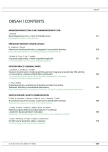The Importance of Brain Activity Monitoring with Integrated EEG Amplitude in Neonates with Early Asphyxia Syndrome
Authors:
J. Lukášková 1; Z. Tomšíková 2; Z. Kokštein 1
Authors‘ workplace:
Dětská klinika LF UK a FN Hradec Králové
1; Neonatologické oddělení, Nemocnice České Budějovice
2
Published in:
Cesk Slov Neurol N 2008; 71/104(5): 544-551
Category:
Original Paper
Overview
The aim of this study was to confirm the correlation between the type of amplitude-integrated EEG (aEEG) in neonates after perinatal or early postnatal asphyxia and the degree of subsequent hypoxic-ischaemic encephalopathy, and to introduce early aEEG monitoring into clinical practice.
Method and patients:
The aEEG was continually recorded in 45 neonates that had suffered from perinatal asphyxia and 2 neonates with early postnatal asphyxia. Average gestational age was 39 weeks, weight 3147 g, average cord pH was 6.95 and base excess was –17.26. Apgar score in 1st minute was 2, in 5th minute 5 and 10th minute 6. The aEEG traces were recorded with a Cerebral Function Monitor 6000 Olympic Medical and classified according to Hellstrom-Westas. The grade of hypoxic-ischemic encephalopathy was evaluated according to Sarnat-Sarnat classification. The assessment of neurological outcome was not included in this work.
Results:
Hypoxic-ischemic encephalopathy did not develop in 10 out of 47 neonates, 7 newborns had encephalopathy grade I, 15 cases developed encephalopathy grade II and 15 patients showed encephalopathy grade III. All of the neonates who had developed no hypoxic-ischaemic encephalopathy or encephalopathy grade I had “continuous normal voltage” or “discontinuous normal voltage” trace type. The negative predictive value (probability of cases with normal aEEG to develop maximally HIE grade I) was 0.75. All types of traces from “continuous normal voltage” to “flat trace” were recorded in neonates with hypoxic-ischaemic encephalopathy grade II. All cases with encephalopathy grade III showed an abnormal aEEG trace (“burst suppression”, “low voltage” and “flat trace”). The positive predictive value of abnormal aEEG trace to predict the development of HIE grade II or III was 0.92.
Conclusion:
In our study we confirmed the usefulness of aEEG assessment in predicting the development of subsequent hypoxic-ischemic encephalopathy in neonates that have suffered from early asphyxia. Introduction of early non‑invasive EEG monitoring into clinical practice might help to identify cases that could benefit from therapeutic hypothermia.
Key words:
neonate – hypoxic-ischaemic encephalopathy – EEG monitoring – integrated EEG amplitude – hypothermia
Sources
1. Rutherford MA, Azzopardi D, Whitelaw A, Cowan F, Renowden S, Edwards D et al. Mild hypothermia and the distribution of cerebral lesions in neonates with hypoxic-ischemic encephalopathy. Pediatrics 2005; 116(4): 1001–1006.
2. Shankaran S, Laptook AR, Ehrenkranz RA, Tyson JE, McDonald SA, Donovan EF et al. Whole-body hypothermia for neonates with hypoxic-ischemic encephalopathy. N Engl J Med 2005; 353(15): 1574–1584.
3. Thoresen M, Whitelaw A. Therapeutic hypothermia for hypoxic-ischaemic encephalopathy in tle newborn infant. Cur Opin Neurol 2005; 18(2): 111–116.
4. Azzopardi D, Robertson NJ, Cowan FM, Rutheford MA, Rampling M, Edwards AD. Pilot study of treatment with whole body hypothermia for neonatal encephalopathy. Pediatrics 2000; 106(4): 684–694.
5. Al Naqeeb N, Edwards AD, Cowan FM, Azzopardi D. Assesment of neonatal encephalopathy by amplitude-integrated electroencephalography. Pediatrics 1999; 103(6 Pt 1): 1263–1271.
6. Hellström-Westas L, Rosén I, Svenningsen NW. Predictive value of early continuous amplitude integrated EEG recordings on outcome after severe birth asphyxia in full term infants. Arch Dis Child Fetal Neonatal Ed 1995; 72(1): F34–F38.
7. Toet MC, Hellström-Westas L, Groenendaal F, Eken P, de Vries LS. Amplitude integrated EEG 3 and 6 hours after birth in full term neonates with hypoxic-ischaemic encephalopathy. Arch Dis Child Fetal Neonatal Ed 1999; 81(1): F19–F23.
8. Klebermass K, Kuhle S, Kohlhauser-Vollmuth C, Pollak A, Weninger M. Evaluation of the Cerebral Function Monitor as a tool for neurophysiological surveillance in neonatal intensive care patients. Childs Nerv Syst 2001; 17(9): 544–550.
9. Lukášková J. Kontinuální monitorování elektrické mozkové aktivity u novorozenců. Čes-slov Ped 2007; 62(2): 91–97.
10. Hellström-Westas L, Rosén I, de Vries LS, Greisen G. Amplitude-integrated EEG: classification and interpretation in preterm and term infants. NeoReview 2006; 7(2): 76–87.
11. Sarnat HB, Sarnat MS. Neonatal encephalopathy folowing fetal distress. A clinical and electroencephalographic study. Arch Neurol 1976; 33(10): 696–705.
12. Gluckman PD, Wyatt JS, Azzopardi D, Ballard R, Edwards AD, Ferriero DM et al. Selective head cooling with mild systemic hypothermia after neonatal encephalopathy: multicentre randomised trial. Lancet 2005; 365(9460): 663–670.
13. Shalak LF, Laptook AR, Velaphi SC, Perlman JM. Amplitude-integrated electroencephalography coupled with an early neurologic examination enhances prediction of term infants at risk for persistent encephalopathy. Pediatrics 2003; 111(2): 351–357.
14. Battin MR, Penrice J, Gunn TR, Gunn AJ. Treatment of term infants with head cooling and mild systemic hypothermia (35,0 degrees C and 34,5 degrees C) after perinatal asphyxia. Pediatrics 2003; 111(2): 244–251.
15. Rennie JM, Chorley G, Boylan G, Pressler R, Nguyen Y, Hooper R. Non-expert use of the cerebral function monitor for neonatal seizure detection. Arch Dis Child Fetal Neonatal Ed 2004; 89(1): F37–F40.
16. de Vries LS, Hellström-Westas L. Role of cerebral function monitoring in the newborn. Arch Dis Child Fetal Neonatal Ed 2005; 90: F201–F207.
Labels
Paediatric neurology Neurosurgery NeurologyArticle was published in
Czech and Slovak Neurology and Neurosurgery

2008 Issue 5
Most read in this issue
- Lumbar Intradural Disc Herniation Manifesting as Cauda Equina Syndrome – Case Report
- Neurological Disorders in Critical Illness
- Current Diagnostics and Therapy of Oligodendrogliomas
- Neurosarcoidosis: a Rare Case of Sarcoidosis of the Cervical Spinal Cord – Case Report
